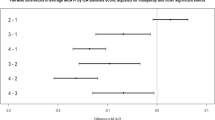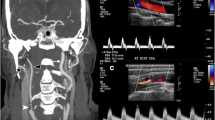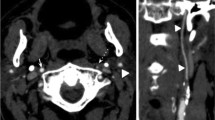Abstract
Purpose
The ultrasonographic and hemodynamic features of patients with carotid near-occlusion (CNO) are still not well known. Our aim was to describe the ultrasonographic and hemodynamic characteristics of a cohort of patients with CNO.
Methods
A prospective, observational, nationwide, and multicenter study was conducted from January/2010 to May/2016. Patients with digital subtraction angiography (DSA)–confirmed CNO were included. We collected information on clinical and demographic characteristics, carotid and transcranial ultrasonography and DSA findings, presence of full-collapse, collateral circulation, and cerebrovascular reactivity (CVR).
Results
One hundred thirty-five patients were analyzed. Ultrasonographic and DSA diagnosis of CNO were concordant in only 44%. This disagreement was related to the presence/absence of full-collapse: 45% of patients with CNO with full-collapse were classified as a complete carotid occlusion, and 40% with a CNO without full-collapse were interpreted as severe stenosis (p < 0.001). Mean velocities (mV) and pulsatility indexes (PIs) were significantly lower in the ipsilateral middle cerebral artery compared with the contralateral (43 cm/s vs 58 cm/s, p < 0.001; 0.80 vs 1.00, p < 0.001). Collateral circulation was identified in 92% of patients, with the anterior communicating artery (73%) being the most frequent. CVR was decreased or exhausted in 66% of cases and was more frequent in patients with a poor or absent collateral network compared with patients with ≥ 2 collateral arteries (82% vs 56%, p = 0.051).
Conclusion
The accuracy of carotid ultrasonography in the diagnosis of CNO seems to be limited, with significant discrepancies with DSA. Decreased ipsilateral mV, PI, and CVR suggest a hemodynamic compromise in patients with CNO.


Similar content being viewed by others
Data Availability
Data of the study are available upon reasonable request.
References
Johansson E, Fox A (2016) Carotid near-occlusion: a comprehensive review, Part 1—Definition, terminology, and diagnosis. Am J Neuroradiol. 37:2–10
Fox AJ, Eliasziw M, Rothwell P, Schmidt M, Warlow C, Barnett H (2005) Identification, prognosis, and management of patients with carotid artery near occlusion. Am J Neuroradiol. 26:2086–2094
Rothwell P, Eliasziw M, Gutnikov S, Fox A, Taylor D, Mayberg M, Warlow CP, Barnett HJM (2003) Analysis of pooled data from the randomised controlled trials of endarterectomy for symptomatic carotid stenosis. Lancet. 361:107–116
Rothwell P, Gutnikov S, Warlow C, for the European Carotid Surgery Trial (2003) Reanalysis of the final results of the European Carotid Surgery Trial. Stroke. 34:514–523
Bartlett E, Walters T, Symons S, Fox A (2006) Diagnosing carotid stenosis near-occlusion by using CT angiography. Am J Neuroradiol. 27:632–637
Khangure S, Benhabib H, Machnowska M, Fox A, Grönlund C, Herod W, Maggisano R, Sjöberg A, Wester P, Hojjat SP, Hopyan J, Aviv RI, Johansson E (2018) Carotid near-occlusion frequently has high peak systolic velocity on Doppler ultrasound. Neuroradiology. 60(1):17–25
Hetzel A, Eckenweber B, Trummer B, Wernz M, Schumacher M, von Reutern G (1998) Colour-coded duplex sonography of preocclusive carotid stenoses. Eur J Ultrasound. 8:183–191
Ashraf Mansour M, Mattos M, Hood D, Hodgson K, Barkmeier L, Ramsey D et al (1995) Detection of total occlusion, string sign, and preocclusive stenosis of the internal carotid artery by color-flow duplex scanning. Am J Surg. 170:154–158
El-Saden S, Grant E, Hathout G, Zimmerman P, Cohen S, Baker J (2001) Imaging of the internal carotid artery: the dilemma of total versus near total occlusion. Radiology. 221:301–308
Johansson E, Fox A (2016) Carotid near-occlusion: a comprehensive review, Part 2—Prognosis and treatment, pathophysiology, confusions, and areas for improvement. Am J Neuroradiol. 37:200–204
Johansson E, Öhman K, Wester P (2015) Symptomatic carotid near-occlusion with full collapse might cause a very high risk of stroke. J Intern Med. 277:615–623
García-Pastor A, Gil-Núñez A, Ramírez-Moreno J, González-Nafría N, Tejada J, Moniche F et al (2019) The risk of recurrent stroke at 24 months in patients with symptomatic carotid near-occlusion: results from CAOS, a multicentre registry study. Eur J Neurol. 26:1391–1398
Grant E, Benson C, Moneta G, Alexandrov A, Baker J, Bluth E et al (2003) Carotid artery stenosis: gray-scale and Doppler US diagnosis--Society of Radiologists in Ultrasound Consensus Conference. Radiology. 229:340–346
Markus H, Harrison M (1992) Estimation of cerebrovascular reactivity using transcranial Doppler, including the use of breath-holding as the vasodilatory stimulus. Stroke. 23:668–673
Jiménez-Caballero P, Segura T (2006) Valores de normalidad de la reactividad vasomotora cerebral mediante el test de apnea voluntaria. Rev Neurol. 43:598–602
Henderson R, Eliasziw M, Fox A, Rothwell P, Barnett H (2000) Angiographically defined collateral circulation and risk of stroke in patients with severe carotid artery stenosis. Stroke. 31(1):128–132
Morgenstern L, Fox A, Sharpe B, Eliasziw M, Barnett H, Grotta J (1997) The risks and benefits of carotid endarterectomy in patients with near occlusion of the carotid artery. Neurology. 48:911–915
Gu T, Aviv R, Fox A, Johansson E (2020) Symptomatic carotid near-occlusion causes a high risk of recurrent ipsilateral ischemic stroke. J Neurol. 267:522–530
Silvestrini M, Troisi E, Matteis M, Cupini L, Caltagirone C (1996) Transcranial Doppler assessment of cerebrovascular reactivity in symptomatic and asymptomatic severe carotid stenosis. Stroke. 27:1970–1973
Terada T, Tsuura M, Matsumoto H, Masuo O, Tsumoto T, Yamaga H, Itakura T (2006) Endovascular treatment for pseudo-occlusion of the internal carotid artery. Neurosurgery. 59:301–309
Choi B, Park J, Shin J, Lü P-H, Kim J, Kim S et al (2010) Outcome evaluation of carotid stenting in high-risk patients with symptomatic carotid near occlusion. Interv Neuroradiol. 16:309–316
González A, Gil-Peralta A, Mayol A, Gonzalez-Marcos J, Moniche F, Aguilar M et al (2011) Internal carotid artery stenting in patients with near occlusion: 30-day and long-term outcome. Am J Neuroradiol. 32:252–258
Oka F, Ishihara H, Kato S, Oku T, Yamane A, Kunitugu I, Suzuki M (2013) Cerebral hemodynamic benefits after carotid artery stenting in patients with near occlusion. J Vasc Surg. 58:1512–1517
Rothwell P, Warlow C (2000) Low risk of ischemic stroke in patients with reduced internal carotid artery lumen diameter distal to severe symptomatic carotid stenosis: cerebral protection due to low poststenotic flow? On behalf of the European Carotid Surgery Trialists’ Collaborative. Stroke. 31:622–630
Molloy J, Markus H (1999) Asymptomatic embolization predicts stroke and TIA risk in patients with carotid artery stenosis. Stroke. 30:1440–1443
Johansson E, Benhabib H, Herod W, Hopyan J, Machnowska M, Maggisano R et al (2018) Carotid near-occlusion can be identified with ultrasound by low flow velocity distal to the stenosis. Acta radiol. 60(3):396–404
Acknowledgements
The data shown in this manuscript has been previously presented as an E-Poster Viewing Abstract at the 5th European Stroke Organisation Conference held in Milan, Italy in May 2019.
Funding
This study received no specific grant from any funding agency in the public, commercial or not-for-profit sectors.
Author information
Authors and Affiliations
Consortia
Corresponding author
Ethics declarations
Conflict of interest
The authors declare that they have no conflict of interest.
Ethical approval
This study obtained ethics approval from “Comité de Ética e investigación Clínica Hospital General Universitario Gregorio Marañón”, with ID number of the approval: 122/09.
Consent to participate
Participants gave informed consent before taking part in the study.
Additional information
Publisher’s note
Springer Nature remains neutral with regard to jurisdictional claims in published maps and institutional affiliations.
Rights and permissions
About this article
Cite this article
Palacios-Mendoza, M.A., García-Pastor, A., Gil-Núñez, A. et al. Ultrasonographic and hemodynamic characteristics of patients with symptomatic carotid near-occlusion: results from a multicenter registry study. Neuroradiology 63, 705–711 (2021). https://doi.org/10.1007/s00234-020-02567-w
Received:
Accepted:
Published:
Issue Date:
DOI: https://doi.org/10.1007/s00234-020-02567-w




